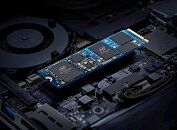Monday, February 10th 2020

Intel Builds 10 million QLC 3D NAND Solid-State Drives
Last week, Intel's memory and storage group produced Intel QLC 3D NAND solid-state drive (SSD) number 10 million based upon the QLC NAND die built in Dalian, China. Production began in late 2018, and this milestone establishes QLC (quadruple-level cell memory) as a mainstream technology for high-capacity drives.
"Many have talked about QLC technology, but Intel has shipped it, and at scale," said Dave Lundell, director of Client SSD Strategic Planning and Product Marketing at Intel. "We have seen strong demand for the cost-effective capacity of our standalone QLC SSD (Intel SSD 660p) and the performance of our Intel Optane Technology + QLC solution (Intel Optane Memory H10)."Here are a few quick facts related to the achievement:
"Many have talked about QLC technology, but Intel has shipped it, and at scale," said Dave Lundell, director of Client SSD Strategic Planning and Product Marketing at Intel. "We have seen strong demand for the cost-effective capacity of our standalone QLC SSD (Intel SSD 660p) and the performance of our Intel Optane Technology + QLC solution (Intel Optane Memory H10)."Here are a few quick facts related to the achievement:
- Intel QLC 3D NAND is used in the Intel SSD 660p, Intel SSD 665p and Intel Optane Memory H10 storage solutions.
- Intel's QLC drive has 4 bits per cell and stores data in both 64-layer and 96-layer NAND configurations.
- Intel has been developing this technology over the past decade. In 2016, Intel engineers changed the orientation of the already-proven floating gate (FG) technology to vertical and wrapped it into a gate all-around structure. The resulting 3D tri-cell level (TLC) technology could store 384 Gb/die. In 2018, 3D QLC flash became a reality, featuring 64 layers with four bits per cell, capable of storing a 1,024 Gb/die. In 2019 Intel moved to 96 layers, reducing overall areal density.
- QLC is now part of Intel's overall storage portfolio, which includes both client and data center products.

22 Comments on Intel Builds 10 million QLC 3D NAND Solid-State Drives
The old TechReport SSD endurance experiment proved that older drives had two orders of magnitude more endurance than any consumer will ever need. QLC endurance diminished that endurance by an order of magnitude, and the passage of time has increased the endurance that your average consumer requires.
At some point - perhaps 5 bits per cell or even lower-grade QLC, we're going to see drives that last barely long enough for a typical consumer build's lifetime.
Seems like a moderate accomplishment , considering their size, revenue & influence...
If this translates into lower prices, greater availability, and more innovation in the flash space, then I'm all for that, but if not, it just seems like grandstanding to me :)
Next step is a fan on it ? :D
TPU made the test, it's horrifying how it can heat so much so fast. They made a test with a 120mm fan on most of them just out of curiosity.
Unless someone comes up with a breakthrough in W/E cycle durability, QLC is unacceptably fragile.
Its why I went with the SX8200 480GB model. USA made Micron flash on it. Fast too when hooked to the NVMe slot going straight to the CPU. (TR ftw) Not a bad deal for I believe it was $54.99?
I use a 1TB 660p in my mission-critical office computer. Of that, usage hovers around 100GB which remains in that sweet SLC territory.
My only complaint is that I'd rather be able to set it to 750GB of capacity and force TLC.
I've been saying that they are low-end drives for a while now, again especially considering their available resources, volume, and market cap...
There are soooo many far better performing drives with less issues than theirs, so those mfgr's will get my drive money way, way before Intel ever will...
The Intel 660p, for example, has a peak consumption of just 4W, that's about 30% less than most other NVMe drives. It's average power consumption is incredibly low at just 2.2W - not something I would associate with 110°C temperatures you're talking about. More importantly, it thermal throttles at 80°C, which means it can't get any hotter than that by itself. If it isn't drawing as much power as other drives, the laws of physics say that it shouldn't get any hotter than other drives (of the same physical size)
If there was a 110°C SSD in my laptop, I think I'd feel that on my leg. Surprisingly, I don't because mine is running at a perfectly normal 67°C at the moment as I throw a 25GB CrystalDiskmark cycle at it for science.
Which TPU test are your referring to with these insane temperature claims - can you link it please?
I searched TPU's review database for "660p" and "QLC" and there aren't any matches.
The fact is I remembered mainly that :
Heat is not well dissipated in a QLC chip because of the +33% density over the same (nearly) heat generated on a lower surface.
So it can't handle it.
Some are downgrading transfer speed, some are making rollercoasters in transfer rate, but the problem exists IMHO. Surely not as deep as I remembered but still :
www.techpowerup.com/review/crucial-p1-nvme-m-2-ssd-1-tb/7.html
With a fan it's working ! (sadly)
Meanwhile TLC can handle higher temperature before throttling :